radiator MERCEDES-BENZ GLC-Class 2016 X253 Owner's Manual
[x] Cancel search | Manufacturer: MERCEDES-BENZ, Model Year: 2016, Model line: GLC-Class, Model: MERCEDES-BENZ GLC-Class 2016 X253Pages: 418, PDF Size: 9.23 MB
Page 13 of 418
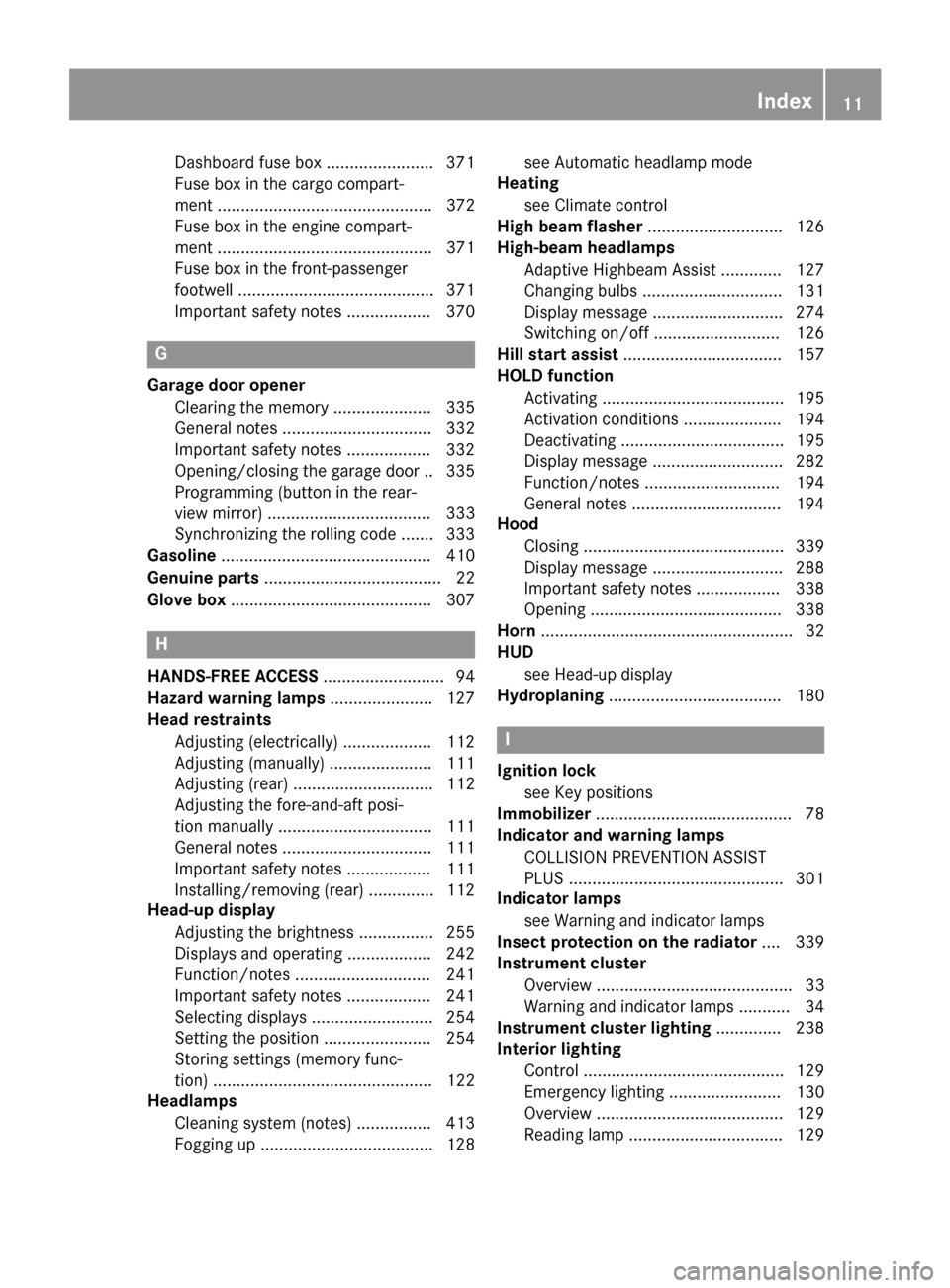
Dashboard fuse box ....................... 371
Fuse box in the cargo compart-
ment .............................................. 372
Fuse box in the engine compart-
ment .............................................. 371
Fuse box in the front-passenger
footwell .......................................... 371
Important safety notes .................. 370
G
Garage door openerClearing the memory ..................... 335
General notes ................................ 332
Important safety notes .................. 332
Opening/closing the garage doo r..3 35
Programming (button in the rear-
view mirror) ................................... 333
Synchronizing the rolling code ....... 333
Gasoline ............................................. 410
Genuine parts ...................................... 22
Glove box ...........................................3 07
H
HANDS-FREE ACCESS.......................... 94
Hazard warning lamps ......................127
Head restraints
Adjusting (electrically) ................... 112
Adjusting (manually) ......................1 11
Adjusting (rear) .............................. 112
Adjusting the fore-and-aft posi-
tion manually ................................. 111
General notes ................................ 111
Important safety notes .................. 111
Installing/removing (rear) .............. 112
Head-up display
Adjusting the brightness ................ 255
Displays and operating .................. 242
Function/notes .............................2 41
Important safety notes .................. 241
Selecting displays .......................... 254
Setting the position ....................... 254
Storing settings (memory func-
tion) ............................................... 122
Headlamps
Cleaning system (notes) ................ 413
Fogging up ..................................... 128 see Automatic headlamp mode
Heating
see Climate control
High beam flasher .............................1 26
High-beam headlamps
Adaptive Highbeam Assist ............. 127
Changing bulbs .............................. 131
Display message ............................ 274
Switching on/off ........................... 126
Hill start assist .................................. 157
HOLD function
Activating ....................................... 195
Activation conditions ..................... 194
Deactivating ................................... 195
Display message ............................ 282
Function/notes .............................1 94
General notes ................................ 194
Hood
Closing ...........................................3 39
Display message ............................ 288
Important safety notes .................. 338
Opening ......................................... 338
Horn ...................................................... 32
HUD
see Head-up display
Hydroplaning ..................................... 180
I
Ignition lock
see Key positions
Immobilizer .......................................... 78
Indicator and warning lamps
COLLISION PREVENTION ASSIST
PLUS .............................................. 301
Indicator lamps
see Warning and indicator lamps
Insect protection on the radiator .... 339
Instrument cluster
Overview .......................................... 33
Warning and indicator lamps ........... 34
Instrument cluster lighting .............. 238
Interior lighting
Control ...........................................1 29
Emergency lighting ........................ 130
Overview ........................................ 129
Reading lamp ................................. 129
Index11
Page 17 of 418

Driving system ............................... 198
Function/notes ............................. 198
Important safety notes .................. 198
Problem (malfunction) ................... 201
Range of the sensors ..................... 198
Warning display ............................. 199
PASSENGER AIR BAG
Display message ............................ 271
Indicator lamps ................................ 43
Problems (malfunction) .................. 271
Perfume atomizer
Operating ....................................... 147
Perfume vial ................................... 147
Problem (malfunction) ................... 149
Pets in the vehicle ............................... 66
Plastic trim (cleaning instruc-
tions) .................................................. 350
Power washers .................................. 345
Power windows
see Side windows
PRE-SAFE
®(anticipatory occupant
protection)
Display message ............................ 265
Operation ......................................... 59
PRE-SAFE
®Brake
Activating/deactivating ................. 253
Display message ............................ 266
Function/notes ................................ 75
Important safety notes .................... 76
Warning lamp ................................. 301
PRE-SAFE
®PLUS (anticipatory
occupant protection PLUS)
Operation ......................................... 59
Protection against theft
ATA (Anti-Theft Alarm system) ......... 78
Immobilizer ...................................... 78
Protection of the environment
General notes .................................. 22
Pulling away
Automatic transmission ................. 157
General notes ................................ 157
Hill start assist ............................... 157
Trailer ............................................ 157
Q
QR codeMercedes-Benz Guide App ................. 1 Rescue card ..................................... 28
Qualified specialist workshop ........... 27
R
Radiator cover................................... 339
Radio
Selecting a station ......................... 248
Radio-wave reception/transmis-
sion in the vehicle
Declaration of conformity ................ 26
Reading lamp ..................................... 129
Rear compartment
Setting the air vents ...................... 150
Rear fog lamp
Display message ............................ 274
Switching on/off ........................... 125
Rear lamps
see Lights
Rear seat
Adjusting the angle of the backr-
ests ................................................ 312
Rear seats
Display message ............................ 289
Rear view camera
Cleaning instructions ..................... 348
Displays in the Audio display ......... 207
Displays in the COMAND display ... 207
Function/notes ............................. 206
Switching on/off ........................... 207
Rear window defroster
Problem (malfunction) ................... 147
Switching on/off ........................... 146
Rear window wiper
Replacing the wiper blade .............. 137
Switching on/off ........................... 135
Rear-view mirror
Anti-glare (manual) ........................ 118
Dipping (automatic) ....................... 120
Reflective safety jacket .................... 354
Refrigerant (air-conditioning sys-
tem)
Important safety notes .................. 414
Refueling
Fuel gauge ....................................... 33
Important safety notes .................. 169
Refueling process .......................... 170
see Fuel
Index15
Page 23 of 418
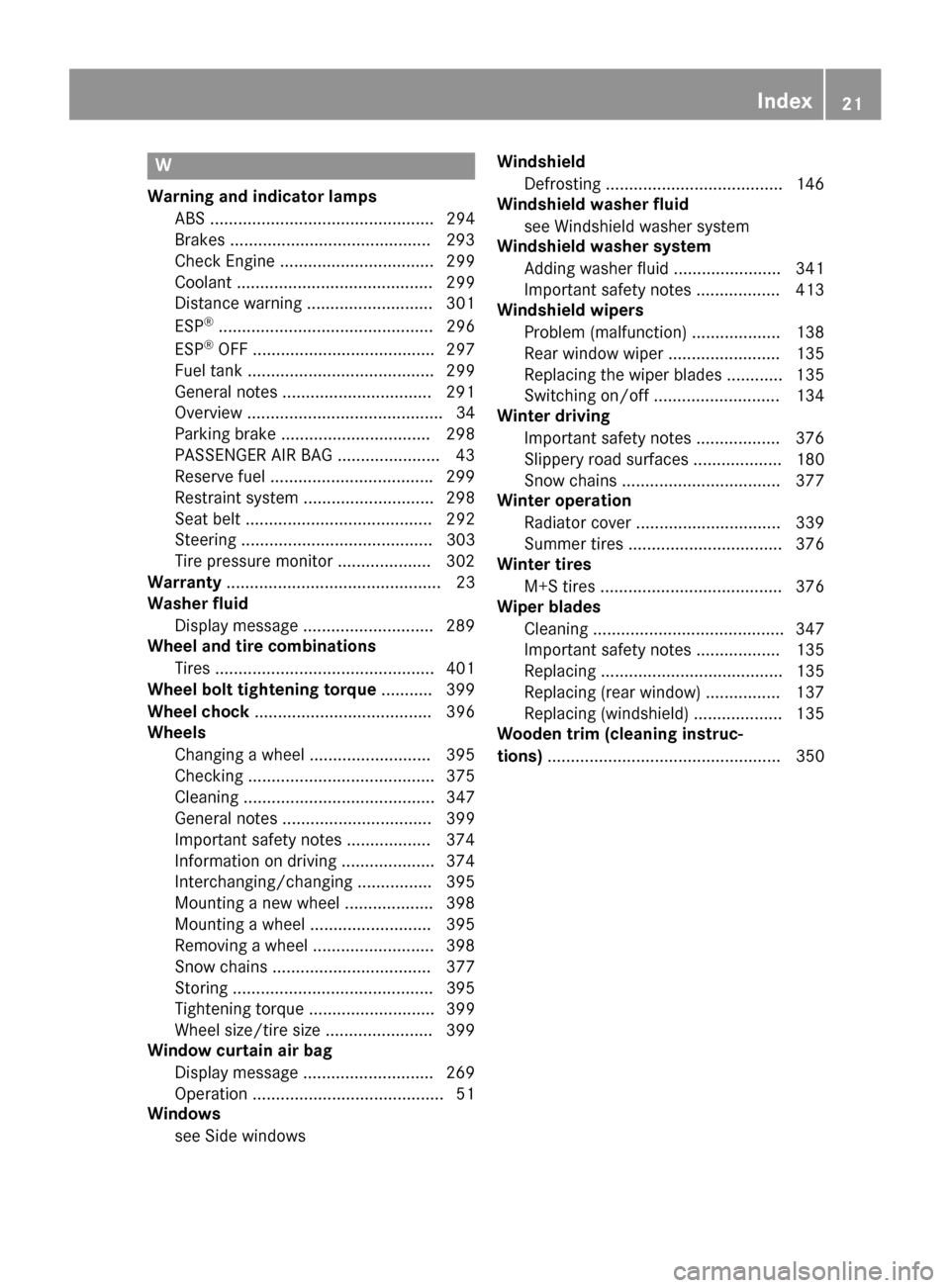
W
Warning and indicator lampsABS ................................................ 294
Brakes ...........................................2 93
Check Engine ................................. 299
Coolant .......................................... 299
Distance warning ........................... 301
ESP
®.............................................. 296
ESP®OFF ....................................... 297
Fuel tank ........................................ 299
General notes ................................ 291
Overview .......................................... 34
Parking brake ................................ 298
PASSENGER AIR BAG ......................4 3
Reserv efuel .................................. .299
Restraint system ............................ 298
Seat belt ........................................ 292
Steering ......................................... 303
Tire pressure monitor .................... 302
Warranty .............................................. 23
Washer fluid
Display message ............................ 289
Wheel and tire combinations
Tires ............................................... 401
Wheel bolt tightening torque ........... 399
Wheel chock ...................................... 396
Wheels
Changing a wheel .......................... 395
Checking ........................................ 375
Cleaning ......................................... 347
General notes ................................ 399
Important safety notes .................. 374
Information on driving .................... 374
Interchanging/changing ................ 395
Mounting a new wheel ................... 398
Mounting a wheel .......................... 395
Removing a wheel .......................... 398
Snow chains .................................. 377
Storing ...........................................3 95
Tightening torque ........................... 399
Wheel size/tire size ....................... 399
Window curtain air bag
Display message ............................ 269
Operation ......................................... 51
Windows
see Side windows Windshield
Defrosting .............. ........................ 146
Wi
ndshield washer fluid
see Windshield washer system
Windshield washer system
Adding washer fluid ....................... 341
Important safety notes .................. 413
Windshield wipers
Problem (malfunction) ................... 138
Rear window wiper ........................ 135
Replacing the wiper blades ............ 135
Switching on/off ........................... 134
Winter driving
Important safety notes .................. 376
Slippery road surfaces ................... 180
Snow chains .................................. 377
Winter operation
Radiator cover ............................... 339
Summer tires ................................. 376
Winter tires
M+S tires ....................................... 376
Wiper blades
Cleaning ......................................... 347
Important safety notes .................. 135
Replacing ....................................... 135
Replacing (rear window) ................ 137
Replacing (windshield) ................... 135
Wooden trim (cleaning instruc-
tions) .................................................. 350
Index21
Page 224 of 418
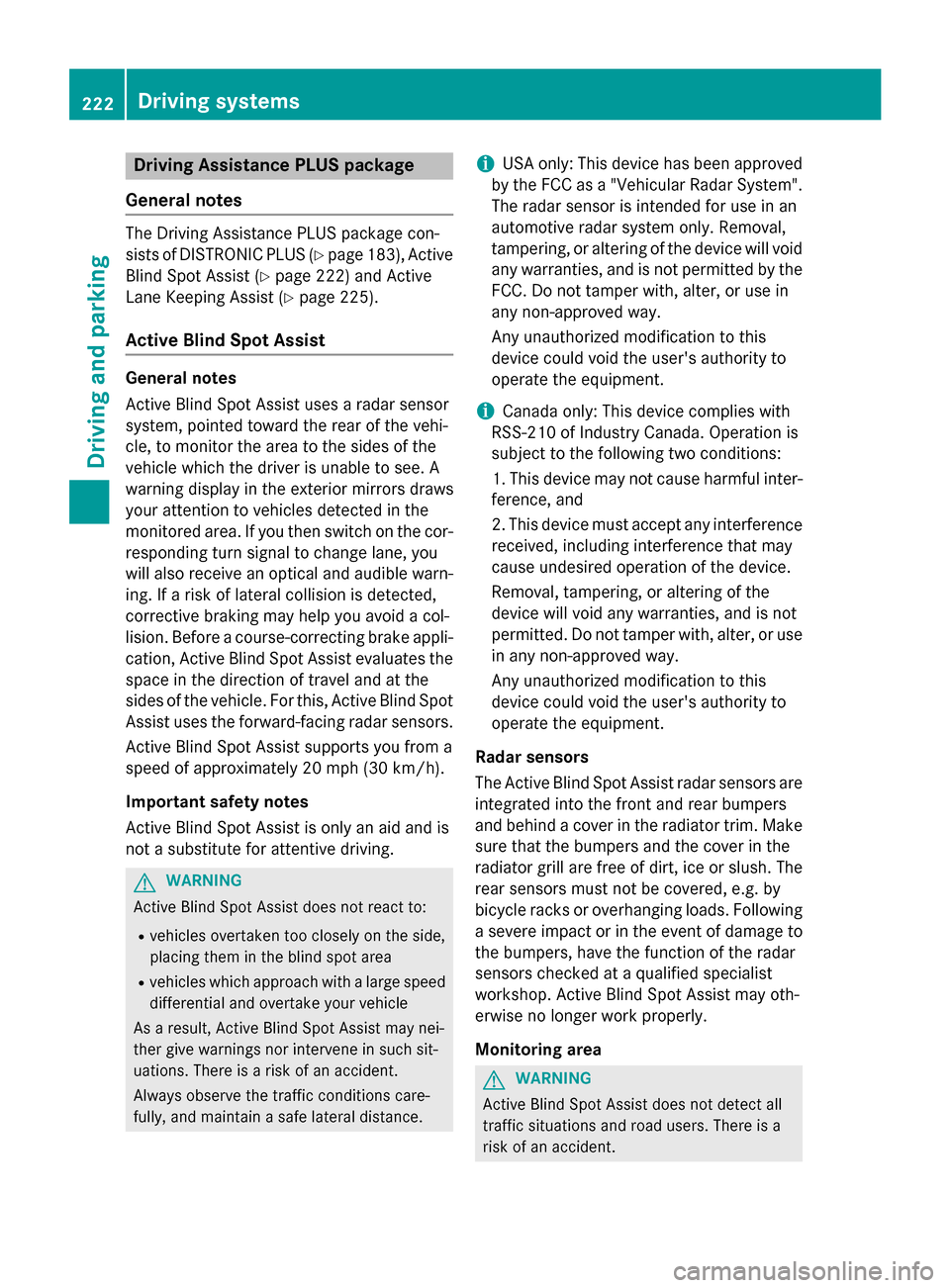
DrivingAssistance PLUS package
General notes
The Driving Assistanc ePLU Spackage con-
sists of DISTRONIC PLU S (
Ypage 183), Active
Blin dSpot Assis t (
Ypage 222) and Active
Lan eKeepin gAssis t (
Ypage 225).
Active Blind Spot Assist
General notes
Active Blin dSpot Assis tuses aradar sensor
system, pointe dtoward th erea rof th evehi-
cle, to monito rth eare ato th esides of th e
vehicle whic hth edriver is unable to see . A
warnin gdisplay in th eexterio rmirrors draws
your attention to vehicles detecte din th e
monitored area. If you then switch on th ecor-
respondin gturn signal to chang elane, you
will also receiv ean optical and audible warn -
ing. If aris kof latera lcollision is detected,
corrective braking may hel pyou avoid acol-
lision .Before acourse-correcting brake appli -
cation ,Active Blin dSpot Assis tevaluates th e
spac ein th edirection of trave land at th e
sides of th evehicle. Fo rthis, Active Blin dSpot
Assis tuses th eforward-facin gradar sensors.
Active Blin dSpot Assis tsupports you from a
speed of approximately 20 mph (30 km/h).
Important safet ynotes
Active Blin dSpot Assis tis only an aid and is
no t a substitute fo rattentive driving.
GWARNING
Active Blin dSpot Assis tdoe sno treact to :
Rvehicles overtaken to oclosely on th eside,
placin gthem in th eblin dspo tare a
Rvehicles whic happroac hwit h a larg espeed
differential and overtak eyour vehicle
As aresult ,Active Blin dSpot Assis tmay nei-
ther giv ewarnings no rinterven ein suc hsit -
uations. There is aris kof an accident.
Always observ eth etraffic condition scare-
fully, and maintain asaf elatera ldistance.
iUS Aonly: Thi sdevic ehas been approved
by th eFCC as a"Vehicular Radar System".
The radar sensor is intended fo ruse in an
automotive radar system only. Removal,
tampering, or altering of th edevic ewill void
any warranties ,and is no tpermitte dby th e
FCC. Do no ttampe rwith, alter, or use in
any non-approved way.
An yunauthorized modification to this
devic ecould void th euser's authorit yto
operat eth eequipment.
iCanada only: Thi sdevic ecomplies wit h
RSS-210 of Industry Canada. Operation is
subjec tto th efollowing tw oconditions:
1. Thi sdevic emay no tcaus eharmful inter-
ference ,and
2. Thi sdevic emus taccept any interfere
nce
re
ceived, includin ginterferenc ethat may
caus eundesired operation of th edevice.
Removal, tampering, or altering of th e
devic ewill void any warranties ,and is no t
permitted. Do no ttampe rwith, alter, or use
in any non-approved way.
An yunauthorized modification to this
devic ecould void th euser's authorit yto
operat eth eequipment.
Rada rsensor s
The Active Blin dSpot Assis tradar sensor sare
integrated into th efron tand rea rbumper s
and behin d acover in th eradiator trim. Mak e
sur ethat th ebumper sand th ecover in th e
radiator grill are free of dirt, ic eor slush. The
rea rsensor smus tno tbe covered, e.g. by
bicycl eracks or overhangin gloads. Following
a severe impact or in th eevent of damage to
th ebumpers, hav eth efunction of th eradar
sensor schecke dat aqualified specialist
workshop .Active Blin dSpot Assis tmay oth-
erwise no longer wor kproperly.
Monitoring area
GWARNING
Active Blind Spot Assis tdoe sno tdetec tall
traffic situation sand road users. There is a
ris kof an accident.
222Driving systems
Driving an d parking
Page 227 of 418
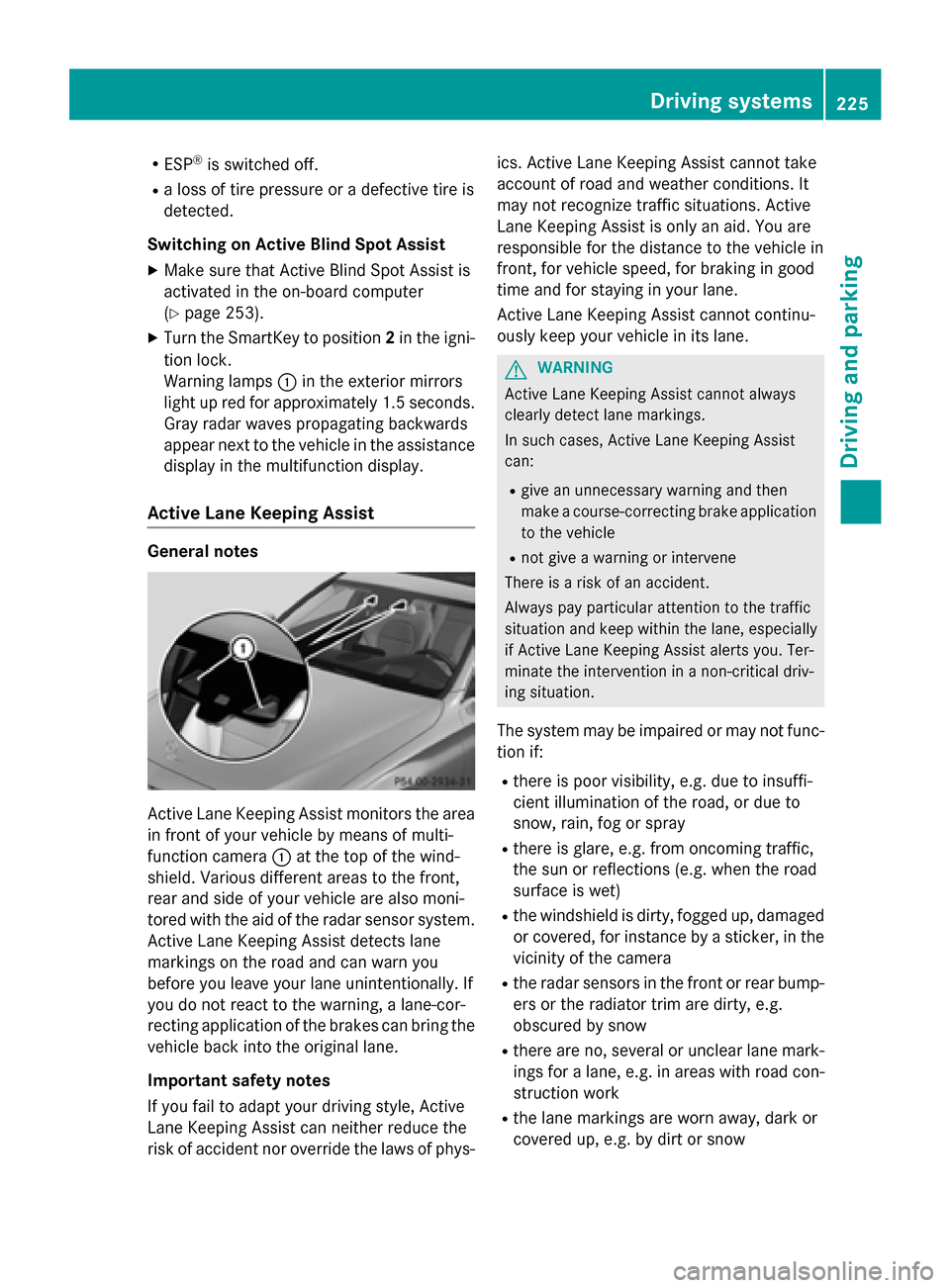
RESP®is switched off.
Ra loss of tire pressure or a defective tire is
detected.
Switching on Active Blind Spot Assist
XMake sure that Active Blind Spot Assist is
activated in the on-board computer
(
Ypage 253).
XTurn the SmartKey to position 2in the igni-
tion lock.
Warning lamps :in the exterior mirrors
light up red for approximately 1.5 second s.
Gray radar waves propagating backwards
appear next to the vehicle in the assistance
display in the multifunction display.
Active Lane Keeping Assist
General notes
Active Lane Keeping Assist monitors the area
in front of your vehicle by means of multi-
function camera :at the top of the wind-
shield. Various different areas to the front,
rear and side of your vehicle are also moni-
tored with the aid of the radar sensor system.
Active Lane Keeping Assist detects lane
markings on the road and can warn you
before you leave your lane unintentionally. If
you do not react to the warning, a lane-cor-
recting application of the brakes can bring the
vehicle back into the original lane.
Important safety notes
If you fail to adapt your driving style, Active
Lane Keeping Assist can neither reduce the
risk of accident nor override the laws of phys- ics. Active Lane Keeping Assist cannot take
account of road and weather conditions. It
may not recognize traffic situations. Active
Lane Keeping Assist is only an aid. You are
responsible for the distance to the vehicle in
front, for vehicle speed, for braking in good
time and for staying in your lane.
Active Lane Keeping Assist cannot continu-
ously keep your vehicle in its lane.
GWARNING
Active Lane Keeping Assist cannot always
clearly detect lane markings.
In such cases, Active Lane Keeping Assist
can:
Rgive an unnecessary warning and then
make a course-correcting brake application
to the vehicle
Rnot give a warning or intervene
There isa risk of an accident.
Always pay particular attention to the traffic
situation and keep within the lane, especially
if Active Lane Keeping Assist alerts you. Ter-
minate the intervention ina non-critical driv-
ing situation.
The system may be impaired or may not func-
tion if:
Rthere is poor visibility, e.g. due to insuffi-
cient illumination of the road, or due to
snow, rain, fog or spray
Rthere is glare, e.g. from oncoming traffic,
the sun or reflections (e.g. when the road
surface is wet)
Rthe windshield is dirty, fogged up, damaged or covered, for instance by a sticker, in the
vicinity of the camera
Rthe radar sensors in the front or rear bump-
ers or the radiator trim are dirty, e.g.
obscured by snow
Rthere are no, several or unclear lane mark- ings for a lane, e.g. in areas with road con-
struction work
Rthe lane markings are worn away, dark or
covered up, e.g. by dirt or snow
Driving systems225
Driving and parking
Z
Page 278 of 418
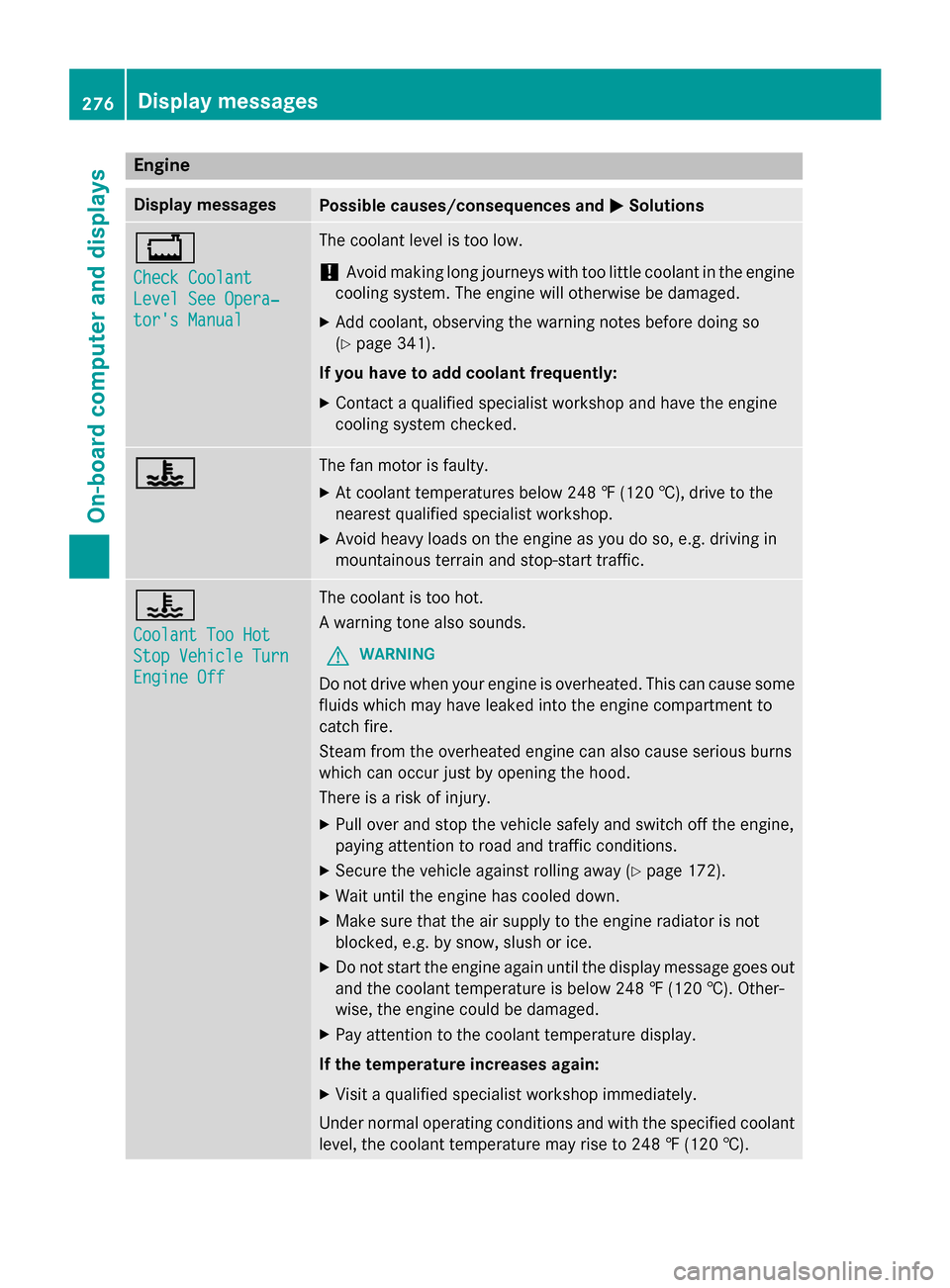
Engine
Display messagesPossible causes/consequences andMSolutions
+
Check Coolant
Level See Opera‐
tor's Manual
The coolant level is too low.
!Avoid making long journeys with too little coolant in the engine
cooling system. The engine will otherwise be damaged.
XAdd coolant, observing the warning notes before doing so
(
Ypage 341).
If you have to add coolant frequently:
XContact a qualified specialist workshop and have the engine
cooling system checked.
?The fan motor is faulty.
XAt coolant temperatures below 248 ‡ (120 †), drive to the
nearest qualified specialist workshop.
XAvoid heavy loads on the engine as you do so, e.g. driving in
mountainous terrain and stop-start traffic.
?
Coolant Too Hot
Stop Vehicle Turn
Engine Off
The coolant is too hot.
A warning tone also sounds.
GWARNING
Do not drive when your engine is overheated. This can cause some
fluids which may have leaked into the engine compartment to
catch fire.
Steam from the overheated engine can also cause serious burns
which can occur just by opening the hood.
There is a risk of injury.
XPull over and stop the vehicle safely and switch off the engine,
paying attention to road and traffic conditions.
XSecure the vehicle against rolling away (Ypage 172).
XWait until the engine has cooled down.
XMake sure that the air supply to the engine radiator is not
blocked, e.g. by snow, slush or ice.
XDo not start the engine again until the display message goes out
and the coolant temperature is below 248 ‡ (120 †). Other-
wise, the engine could be damaged.
XPay attention to the coolant temperature display.
If the temperature increases again:
XVisit a qualified specialist workshop immediately.
Under normal operating conditions and with the specified coolant
level, the coolant temperature may rise to 248 ‡ (120†) .
276Displa y messages
On-board computer and displays
Page 302 of 418
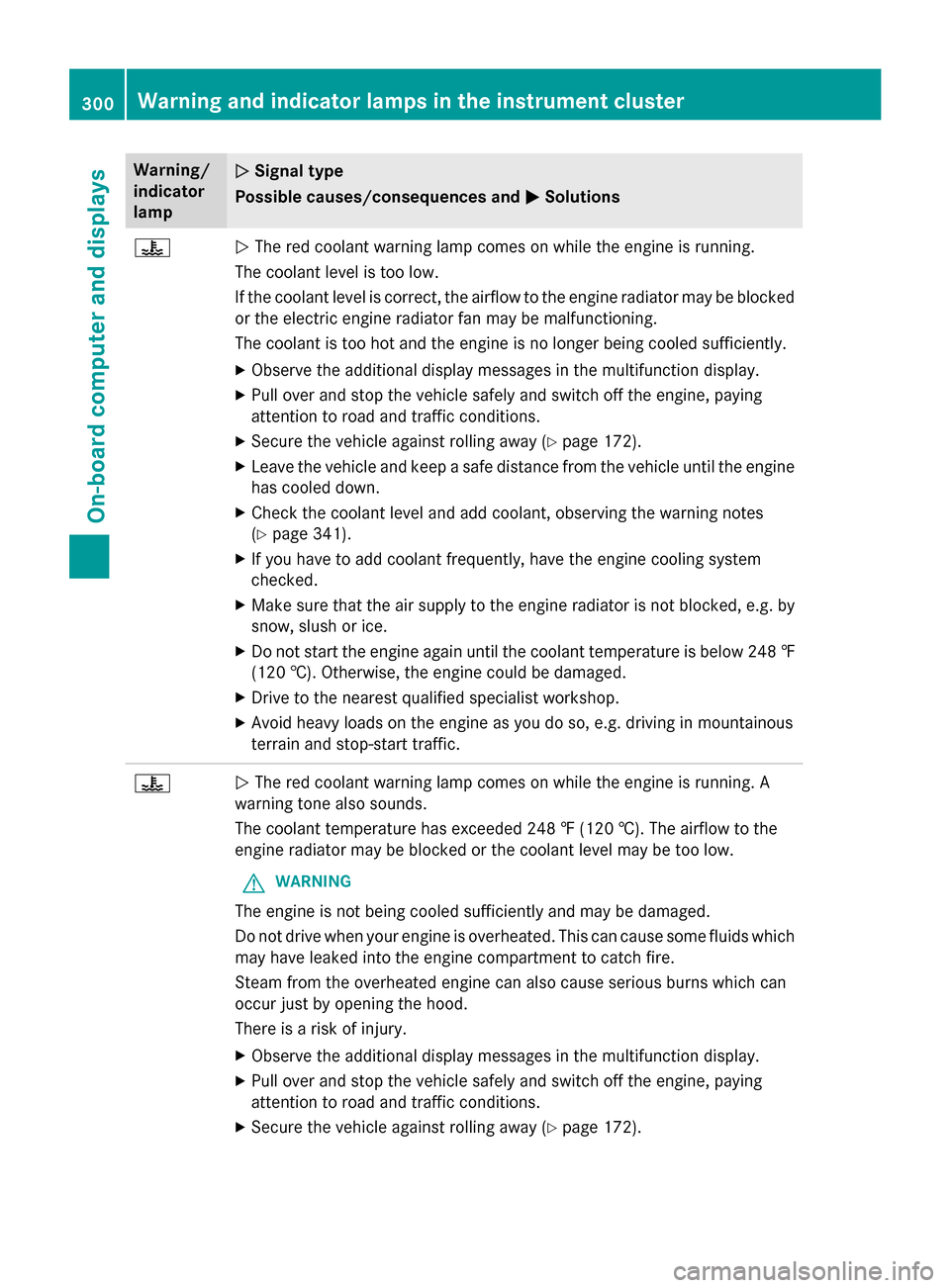
Warning/
indicator
lampNSignal type
Possible causes/consequences and M
Solutions
?NThe red coolant warning lamp comes on while the engine is running.
The coolant level is too low.
If the coolant level is correct, the airflow to the engine radiator may be blocked
or the electric engine radiator fan may be malfunctioning.
The coolant is too hot and the engine is no longer being cooled sufficiently.
XObserve the additional display messages in the multifunction display.
XPull over and stop the vehicle safely and switch off the engine, paying
attention to road and traffic conditions.
XSecure the vehicle against rolling away (Ypage 172).
XLeave the vehicle and keep a safe distance from the vehicle until the engine has cooled down.
XCheck the coolant level and add coolant, observing the warning notes
(
Ypage 341).
XIf you have to add coolant frequently, have the engine cooling system
checked.
XMake sure that the air supply to the engine radiator is not blocked, e.g. by
snow, slush or ice.
XDo not start the engine again until the coolant temperature is below 248 ‡
(120 †). Otherwise, the engine could be damaged.
XDrive to the nearest qualified specialist workshop.
XAvoid heavy loads on the engine as you do so, e.g. driving in mountainous
terrain and stop-start traffic.
?N The red coolant warning lamp comes on while the engine is running. A
warning tone also sounds.
The coolant temperature has exceeded 248 ‡ (120 †). The airflow to the
engine radiator may be blocked or the coolant level may be too low.
GWARNING
The engine is not being cooled sufficiently and may be damaged.
Do not drive when your engine is overheated. This can cause some fluids which
may have leaked into the engine compartment to catch fire.
Steam from the overheated engine can also cause serious burns which can
occur just by opening the hood.
There is a risk of injury.
XObserve the additional display messages in the multifunction display.
XPull over and stop the vehicle safely and switch off the engine, paying
attention to road and traffic conditions.
XSecure the vehicle against rolling away (Ypage 172).
300Warning and indicator lamps in the instrument cluster
On-board computer and displays
Page 303 of 418
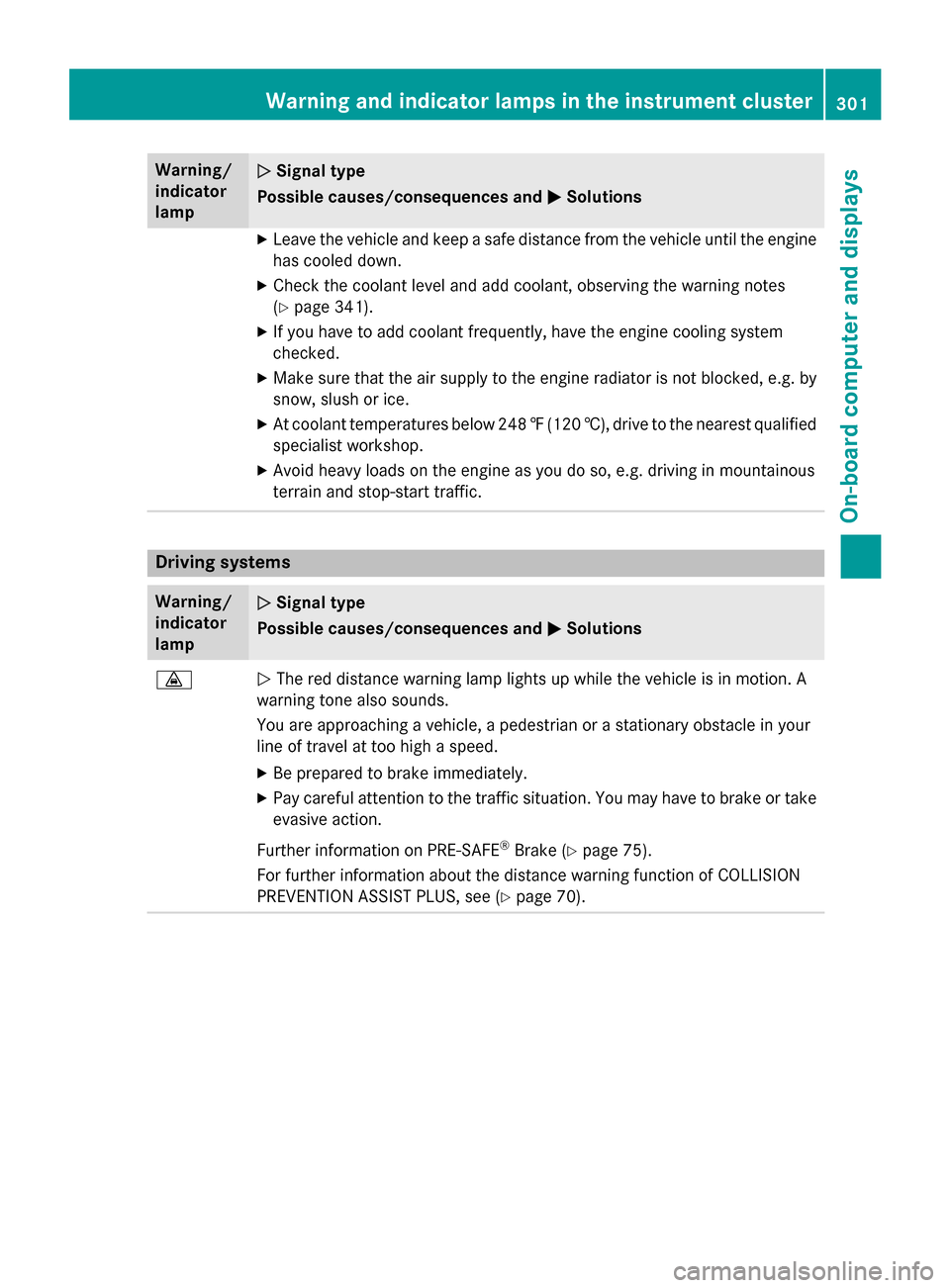
Warning/
indicator
lampNSignal type
Possible causes/consequences and M
Solutions
XLeave the vehicle and keep a safe distance from the vehicle until the engine
has cooled down.
XCheck the coolant level and add coolant, observing the warning notes
(
Ypage 341).
XIf you have to add coolant frequently, have the engine cooling system
checked.
XMake sure that the air supply to the engine radiator is not blocked, e.g. by
snow, slush or ice.
XAt coolant temperatures below 248 ‡(120 †), drive to the nearest qualified
specialist workshop.
XAvoid heavy loads on the engine as you do so, e.g. driving in mountainous
terrain and stop-start traffic.
Driving systems
Warning/
indicator
lampNSignal type
Possible causes/consequences and M
Solutions
·NThe red distance warning lamp lights up while the vehicle is in motion. A
warning tone also sounds.
You are approaching a vehicle, a pedestrian or a stationary obstacle in your
line of travel at too high a speed.
XBe prepared to brake immediately.
XPay careful attention to the traffic situation. You may have to brake or take
evasive action.
Further information on PRE ‑SAFE
®Brake (Ypage 75).
For further information about the distance warning function of COLLISION
PREVENTION ASSIST PLUS, see (
Ypage 70).
Warning and indicator lamps in the instrument cluster301
On-board computer and displays
Z
Page 340 of 418
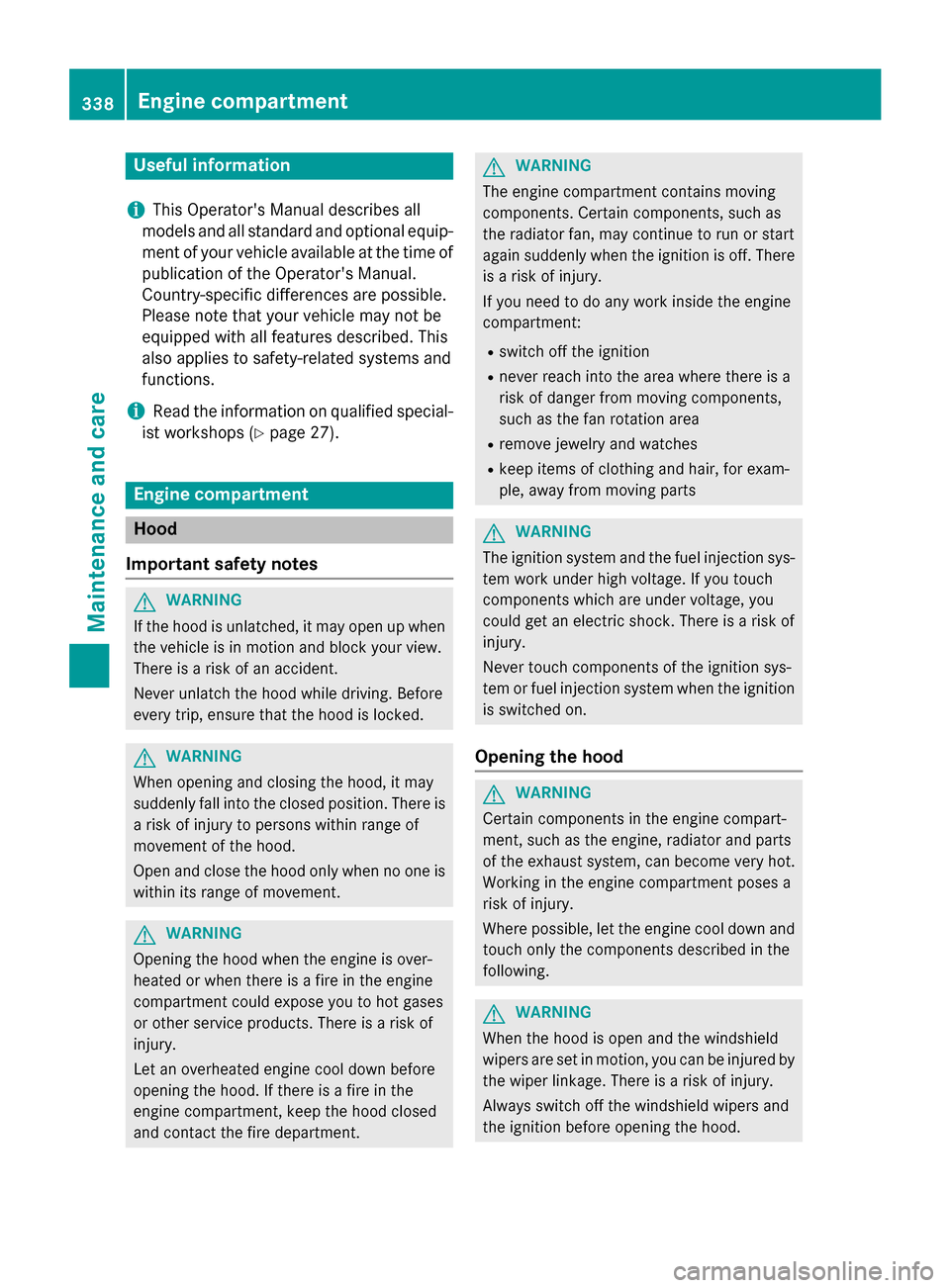
Useful information
i
This Operator's Manual describes all
models and all standard and optional equip-
ment of your vehicle available at the time of
publication of the Operator's Manual.
Country-specific differences are possible.
Please note that your vehicle may not be
equipped with all features described. This
also applies to safety-related systems and
functions.
iRead the information on qualified special-
ist workshops (
Ypage 27).
Engine compartment
Hood
Important safety notes
GWARNING
If the hood is unlatched, it may open up when the vehicle is in motion and block your view.
There is a risk of an accident.
Never unlatch the hood while driving. Before
every trip, ensure that the hood is locked.
GWARNING
When opening and closing the hood, it may
suddenly fall into the closed position. There is a risk of injury to persons within range of
movement of the hood.
Open and close the hood only when no one is
within its range of movement.
GWARNING
Opening the hood when the engine is over-
heated or when there is a fire in the engine
compartment could expose you to hot gases
or other service products. There is a risk of
injury.
Let an overheated engine cool down before
opening the hood. If there is a fire in the
engine compartment, keep the hood closed
and contact the fire department.
GWARNING
The engine compartment contains moving
components. Certain components, such as
the radiator fan, may continue to run or start
again suddenly when the ignition is off. There is a risk of injury.
If you need to do any work inside the engine
compartment:
Rswitch off the ignition
Rnever reach into the area where there is a
risk of danger from moving components,
such as the fan rotation area
Rremove jewelry and watches
Rkeep items of clothing and hair, for exam-
ple, away from moving parts
GWARNING
The ignition system and the fuel injection sys-
tem work under high voltage. If you touch
components which are under voltage, you
could get an electric shock. There is a risk of
injury.
Never touch components of the ignition sys-
tem or fuel injection system when the ignition
is switched on.
Opening the hood
GWARNING
Certain components in the engine compart-
ment, such as the engine, radiator and parts
of the exhaust system, can become very hot.
Working in the engine compartment poses a
risk of injury.
Where possible, let the engine cool down and touch only the components described in the
following.
GWARNING
When the hood is open and the windshield
wipers are set in motion, you can be injured by
the wiper linkage. There is a risk of injury.
Always switch off the windshield wipers and
the ignition before opening the hood.
338Engine compartment
Maintenance and care
Page 341 of 418
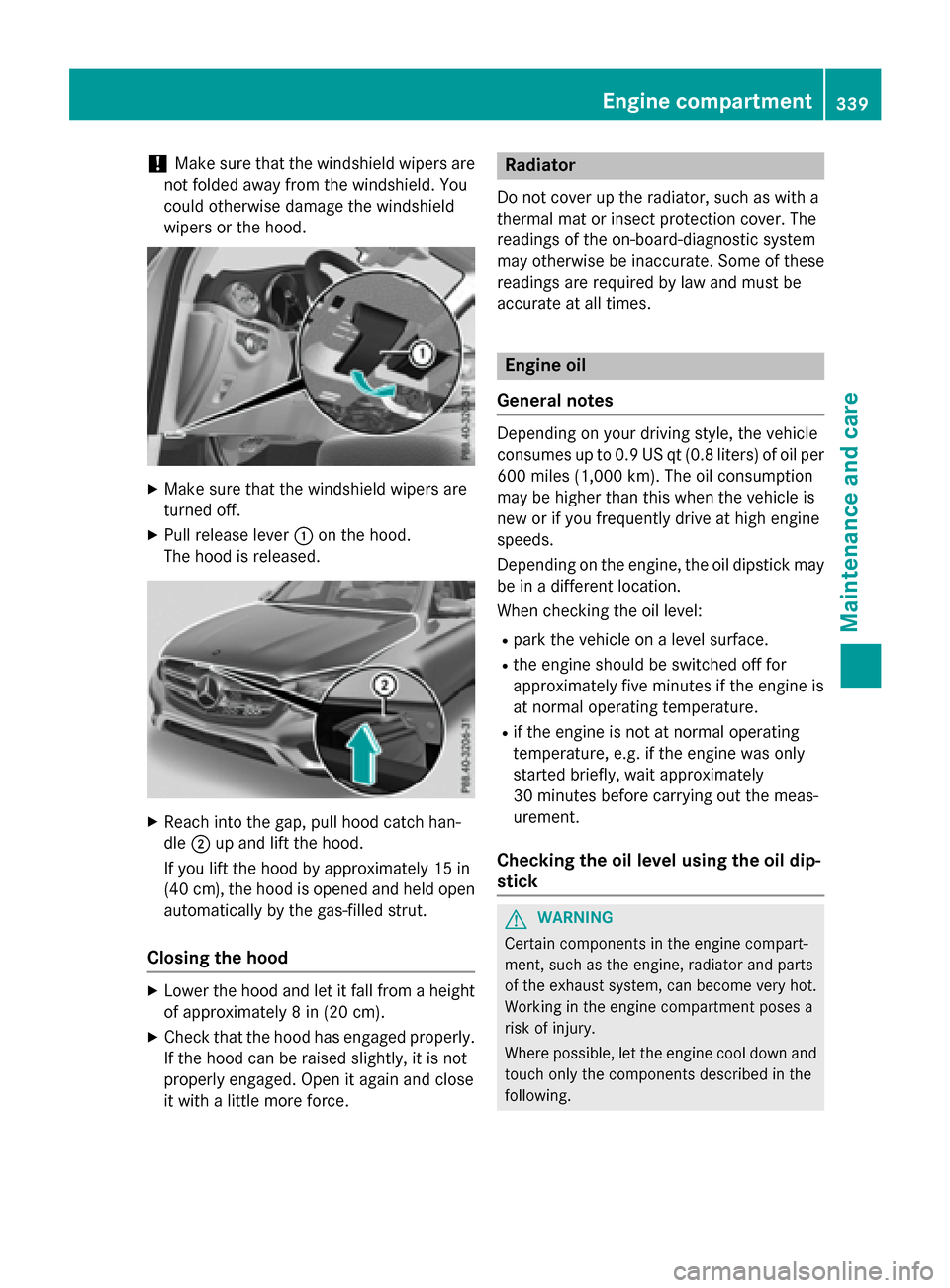
!Make sure that the windshield wipers are
not folded away from the windshield. You
could otherwise damage the windshield
wipers or the hood.
XMake sure that the windshield wipers are
turned off.
XPull release lever :on the hood.
The hood is released.
XReach into the gap, pull hood catch han-
dle ;up and lift the hood.
If you lift the hood by approximately 15 in
(40 cm), the hood is opened and held open automatically by the gas-filled strut.
Closing the hood
XLower the hood and let it fall from a height
of approximately 8 in (20 cm).
XCheck that the hood has engaged properly.
If the hood can be raised slightly, it is not
properly engaged. Open it again and close
it with a little more force.
Radiator
Do not cover up the radiator, such as with a
thermal mat or insect protection cover. The
readings of the on-board-diagnostic system
may otherwise be inaccurate. Some of these
readings are required by law and must be
accurate at all times.
Engine oil
General notes
Depending on your driving style, the vehicle
consumes up to 0.9 US qt (0.8 liters) of oil per
600 miles (1,000 km). The oil consumption
may be higher than this when the vehicle is
new or if you frequently drive at high engine
speeds.
Depending on the engine, the oil dipstick may
be in a different location.
When checking the oil level:
Rpark the vehicle on a level surface.
Rthe engine should be switched off for
approximately five minutes if the engine is
at normal operating temperature.
Rif the engine is not at normal operating
temperature, e.g. if the engine was only
started briefly, wait approximately
30 minutes before carrying out the meas-
urement.
Checking the oil level using the oil dip-
stick
GWARNING
Certain components in the engine compart-
ment, such as the engine, radiator and parts
of the exhaust system, can become very hot.
Working in the engine compartment poses a
risk of injury.
Where possible, let the engine cool down and touch only the components described in the
following.
Engine compartment339
Maintenance and care
Z